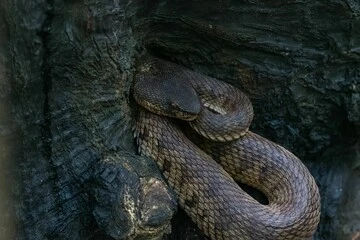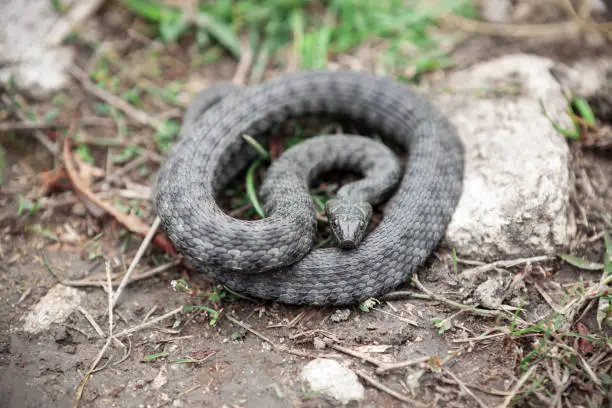Table of Contents
Scientific Classification
| Kingdom | Animalia |
| Phylum | Chordata |
| Class | Reptilia |
| Order | Squamata |
| Family | Colubridae |
| Genus | Nerodia |
| Species | Nerodia rhombifer |
| Scientific Name | Nerodia rhombifer |
Description
The Diamondback Water Snake (Nerodia rhombifer) is a robust, non-venomous snake that often gets mistaken for its venomous cousins. This confusion arises from its striking appearance and the way it behaves when it feels threatened. Its name comes from the distinctive diamond-shaped pattern that adorns its back, showcasing dark brown or black markings that stand out against a lighter brown or olive backdrop. With its thick body and keeled scales, it certainly has a rough and rugged vibe.
Typically, adults measure between 3 to 5 feet long, with females usually being larger than males. Their underbelly is a pale yellow or beige, decorated with dark half-moon-shaped blotches. While they might look intimidating, these snakes are completely harmless to humans and play a vital role in their ecosystems.
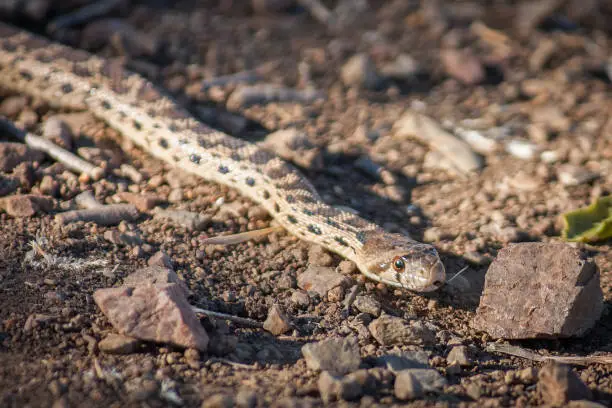
Distribution
Diamondback Water Snakes live in the central and southern United States. Their range includes:
- Texas
- Oklahoma
- Arkansas
- Louisiana
- Mississippi
- Missouri
- Illinois
- Western Tennessee and Kentucky
- Parts of Alabama and Georgia
They are especially common in river valleys and lowland areas within this range.
Habitat
This species loves water. You can usually find it in or near freshwater sources. Ideal habitats include:
- Slow-moving rivers
- Lakes and ponds
- Swamps and marshes
- Bayous and oxbow lakes
- Flooded forests and backwaters
They like water bodies with lots of plants, submerged logs, or overhanging branches. These spots provide good places to hunt and areas to bask or hide.
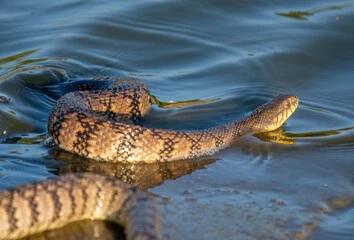
Diet
Diamondback Water Snakes are carnivorous creatures that primarily feast on aquatic and semi-aquatic animals. Their favorite dishes include:
– Fish (especially smaller or slower species like sunfish, catfish, and minnows)
– Amphibians (such as frogs, tadpoles, and toads)
– Small crustaceans (on occasion)
These snakes are skilled hunters, often lying in wait beneath the water’s surface or launching surprise attacks from hidden spots. With their sharp, backward-curving teeth, they can easily grip slippery fish and swallow them whole.
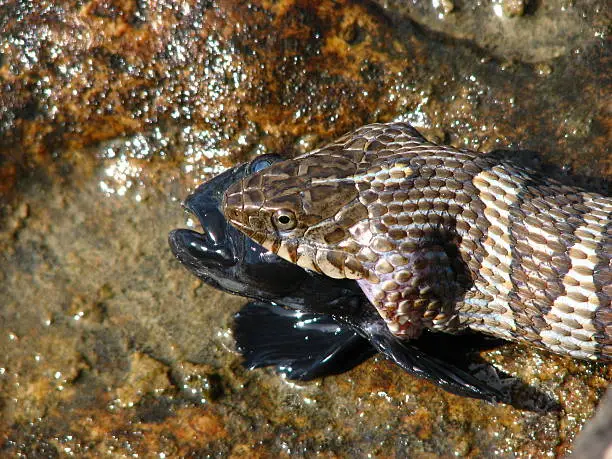
Behavior
These snakes are quite the loners and tend to be most active during the day, especially when the weather warms up. When they’re not out hunting, you can often find them soaking up the sun on tree branches, rocks, or any debris near water.
While they’re not naturally aggressive, Diamondback Water Snakes can be very defensive if they feel threatened. If they find themselves in a tight spot, they might:
– Hiss loudly
– Flatten their bodies
– Release a stinky musk
– Strike repeatedly
During the winter months, they enter a state called brumation, which is similar to hibernation for reptiles. They seek refuge in underwater burrows, crevices, or old dens, patiently waiting for the warmer days to return.
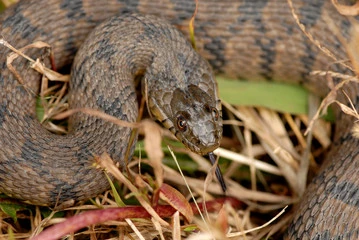
Lifespan
In the wild, Diamondback Water Snakes typically have a lifespan of around 10 to 12 years. However, this can change depending on factors like predators and their surroundings. When kept in captivity and given the right care, they can live for 15 years or even longer!
Reproduction and Lifecycle
Diamondback Water Snakes are viviparous, which means they give birth to live young instead of laying eggs. Mating typically happens soon after they come out of brumation in early spring.
Females usually give birth in late summer or early fall, producing litters that can range from 10 to 50 young, depending on their size and age. The newborns are about 8 to 12 inches long and resemble miniature adults, complete with those distinctive diamond patterns.
These young snakes are on their own right from the start and don’t get any parental care. They do face high mortality rates due to predators, but if they manage to survive their first year, they grow quickly.
Predators
Diamondback Water Snakes use defensive tactics, but they still face many predators. This is especially true for young snakes. Natural enemies include:
- Wading birds (e.g., herons and egrets)
- Larger snakes
- Snapping turtles
- Mammals like raccoons and otters
- Humans (mistakenly killing them out of fear)
Their secret colors help them hide in dark waters. But they are still at risk when basking or hunting at the surface.
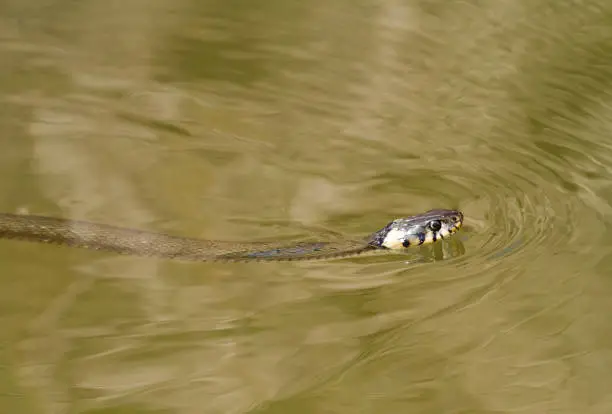
Adaptations
Diamondback Water Snakes possess a suite of adaptations for life in and around water:
- Nostrils sit on top of their snout. This lets them breathe while they are mostly underwater.
- Valved nostrils that close underwater
- Keen eyesight and sensitivity to water vibrations for detecting prey
- Strong swimming ability, aided by muscular, laterally compressed bodies
- Cryptic coloration, helping them remain hidden in dappled water or among vegetation
- Rough, keeled scales, offering protection and camouflage
These features make them great aquatic hunters. They are well-adapted for survival in different wetland areas.
Conservation Status
The IUCN Red List lists the Diamondback Water Snake as Least Concern, meaning it’s not considered endangered or threatened. Thanks to its broad habitat range, flexible diet, and successful reproduction, this species maintains stable populations.
That said, there are long-term threats to their survival, primarily due to habitat loss from wetland drainage, pollution, and urban sprawl. Additionally, some people may harm these snakes, mistaking them for venomous species, which can lead to declines in local populations.
To help ensure their continued existence, it’s crucial to focus on education and habitat conservation.
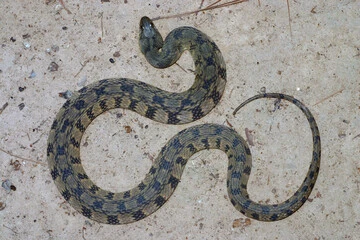
Nest
Unlike their egg-laying reptile cousins, Diamondback Water Snakes don’t bother with building nests. Instead, these fascinating creatures are live-bearers, meaning the females carry their fertilized embryos right inside their bodies. The gestation period typically lasts around 3 to 4 months, during which the female often basks more frequently. This helps her regulate her body temperature and supports the growth of her little ones.
When the moment arrives, she looks for a cozy, humid spot to give birth. This could be among dense vegetation, beneath logs, or in shallow burrows close to water. Once born, the tiny snakes don’t stick around; they quickly disperse, instinctively setting off to find food and shelter on their own.
Mating Season
Diamondback Water Snakes start mating in early spring. This happens right after they come out of winter brumation. Males are very active now. They find females by following pheromones. These are chemical signals left in their trail.
When a male finds a female, he rubs his body against hers. They align themselves before mating. Mating can last for hours. Females may mate with several males in a season. This boosts genetic diversity in their young.
Breeding
Breeding occurs just once a year, typically when females give birth in late summer or early fall, around August to September. Depending on their size and health, a single female can have anywhere from 10 to 50 live young.
Right from the moment they hatch, newborn snakes are ready to start hunting. They can snag small fish or tadpoles almost immediately. While they may be vulnerable at first, their quick growth and natural camouflage help boost their chances of survival. Interestingly, after giving birth, there’s no parental care provided, which is a common characteristic among many snake species.
Interesting Facts
- Did you know some fascinating facts about snakes? For instance, many people confuse harmless Diamondback Water Snakes with venomous ones like the cottonmouth, which often leads to unnecessary fear and even the killing of these non-threatening creatures.
- These snakes are quite remarkable; they can hold their breath underwater for as long as 15 minutes! This ability comes from their slow metabolism and their knack for using oxygen efficiently.
- What’s even more interesting is that Diamondback Water Snakes are quite loyal to their favorite spots. They tend to return to the same basking areas or hiding places time and again.
- Their keeled scales are not just for show; they help them blend into their surroundings, and their rough texture can deter some predators from getting too close.
- Unlike their venomous counterparts, these snakes have round pupils and lack heat-sensing pits, making them quite different in appearance.
- They play a crucial role in maintaining the balance of freshwater ecosystems by keeping populations of small fish and amphibians in check, which is essential for the health of these environments.
- When threatened, they can release a strong-smelling musk from glands near their tail, which serves as an effective deterrent against potential predators.
- Even though they thrive in water, these snakes are also quite agile on land. This ability allows them to seek out new habitats or escape from drying pools, especially during the hot summer months.
- You might notice that their colors can vary significantly; some individuals appear nearly black, while others sport shades of olive or brown.
- Interestingly, some people choose to keep these snakes as pets since they are non-venomous. They are also featured in herpetology exhibits to help educate the public about these fascinating creatures.
Conclusion
The Diamondback Water Snake may not have the same glamorous reputation as some other reptiles, but it certainly holds its own. This fascinating creature plays a vital role in wetland ecosystems. With its unique aquatic lifestyle and impressive reproductive capabilities, it contributes significantly to the ecological balance. Therefore, it truly deserves our recognition, protection, and understanding.
These remarkable snakes should serve as a source of inspiration for us. They remind us of the complexity and diversity of nature, rather than evoking fear or confusion. We have the power to help this incredible snake thrive in its natural environment. By focusing on education, preserving habitats, and promoting peaceful coexistence, we can make a real difference.
